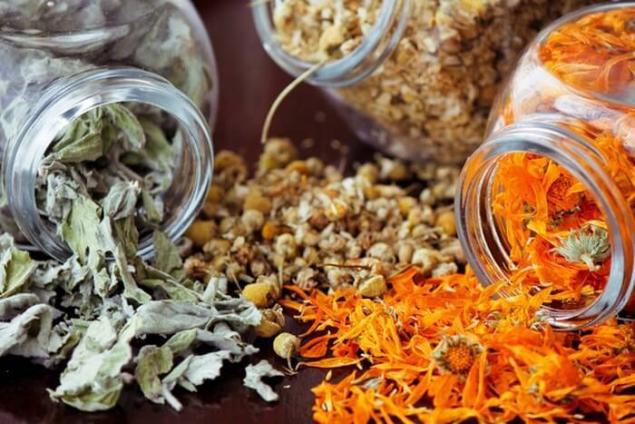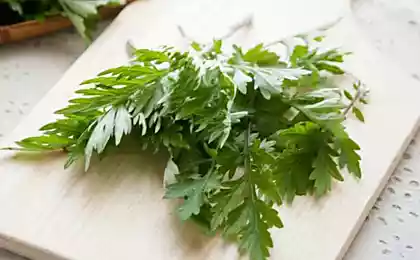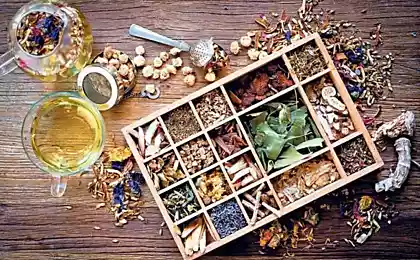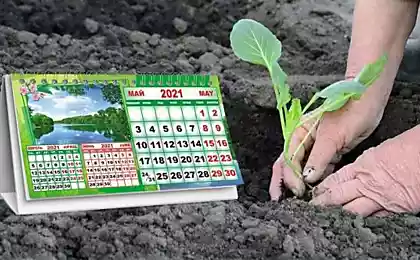577
The secrets of the herbalists: when and what herbs to gather
The moon strongly influences the quality of collected the various parts of plants. In this regard, practice the rules for collection of medicinal plants; in the first phase of the moon it is best to collect rhizomes, roots and tubers, especially in the sixth and seventh lunar day. During this period, energy and trace elements are maximum in the underground parts of plants.
The second phase of the moon are most favorable for collecting above-ground organs of plants. Energy, bottom up makes a lot of minerals. Herbs are best when the Moon is visible.
The third phase of the moon like the first one. This period is also good to dry herbs minerals and other nutrients are better preserved. The fourth phase of the moon second like its properties when collecting herbs.
Chetvertichnye short development cycles (phases) it is convenient to model our seven-day public cycle - allotment. So seemingly absurd at first glance, the approval of experienced herbalists, for example, that psyllium you need to collect on Sunday, actually has a solid scientific basis, namely, the knowledge of rhythms of the plants.

PLANTS OF THE SUN
Sun — men's planet, so the plants help to cope with male-specific diseases. Plants of the Sun stimulate processes in the body — increase blood pressure, increase hair growth, accelerate the maturation of abscesses. Solar plants invigorate, tone the body, strengthen the immune system. Plants Sun — dry, bright, blooming, round, yellow or Golden in color, odorless or with a faint odor, growing in open places. Stem solid, leaves hard. If the tree is tall and straight, with luxuriant foliage. Such plants are: orange, Arnica, immortelle, Valerian, grapes, carnation, heliotrope, hyacinth red, gentian, mustard, elecampane, dyagel, St. John's wort, Ivan-da-Marya, raisins, ginger, calendula (marigold), cinnamon, mullein, Kurolap, Laurel, Buttercup, mother and stepmother, Melissa, almonds, juniper, mint, digitalis, sea buckthorn, cucumber, dandelion, plum, mistletoe, walnuts, eyebright, parsley, tansy, peony, primrose, sycamore, sunflower, wormwood, motherwort, chamomile, Ruta fragrant, sandalwood, pine, bearberry, poplar, series, celandine, fennel, saffron seed, ash.
TIME GATHERING HERBS AND THE SUN
Helichrysum — around noon on the growing moon.
Elecampane — in early August, at noon, on the growing moon and a full moon.
St. John's wort in July, August, from sunrise until noon on the growing moon.
Ivan-da-Marya — before sunrise, in the second quarter of the moon.
Calendula (flowers) — at midday in bright Sunshine, just after the new moon.
Mother-and-stepmother — in the morning at sunrise, on the growing moon.
Melissa — in the morning dew, near full moon.
Digitalis — near sunset, in the third phase of the moon.
Seabuckthorn — from noon to sunset during the full moon.
Cucumber — before sunrise, on the growing moon.
Dandelion (flowers) — in the morning after sunrise on the growing moon.
Sunflower — at noon, at the new moon.
Motherwort — around noon on the growing moon.
Camomile — in the morning dew in Sunny weather, in the first phase of the moon.
Series — in the evening before sunset, near full moon.
PLANTS OF THE MOON
The moon gives the plants razmnozhenii. It affects the pistil, protective covers plants and fruit. Plants of the moon contain a lot of juices, they thickened stems and leaves with pale color and not a strong smell. The flowers are white. According to U.S. scientists from the University of Illinois, full moon vegetable plants grow more rapidly and increase productivity by 15-20%. In the experimental area was cultivated potatoes.
Lunar plants well absorb disease. For example, the leaves of cabbage applied to the inflamed mammary gland. Magical plants moon — Lotus and Lily white lake, willow and all the trees bowed to the water.
Plants of the moon: calamus, watermelon, banana, birch, willow, marine algae, mushrooms, melon, Larkspur, willow, hyssop, cabbage, potatoes, watercress, water Lily, Laurel, Lily of the valley, water Lily, lime, Lotus, onion, juniper, carrot, sea buckthorn, cucumber, aspen, shepherd's purse, plantain, purslane, chamomile, lettuce, marsh cinquefoil, poplar, turnips, pumpkin, tricolor violet, horsetail, rose white, Apple.
WHILE COLLECTING THE HERBS OF THE MOON
Air marsh — near sunset, in the third phase of the moon.
Birch (tussock) -a day in the summer solstice, on the growing moon.
Cabbage, cabbage — before noon, on the growing moon.
Lily of the valley — to the rising Sun on the morning dew, near full moon.
Seabuckthorn — from noon to sunset, the full moon.
Cucumber — before sunrise, on the growing moon.
Plantain (leaf) — during flowering, the evening dew on the growing moon.
Camomile — in the morning dew in Sunny weather in the first quarter of the moon.
PLANTS MERCURY
Curly, dry creeping shrubs, small-leaved plants and plants with variegated coloration, as well as all multi-piece mixture (including chopped salads). To mercury plants include: Azalea, rhododendron, birch, cranberries, Valerian, Heather, bindweed, the weed vermifuge, knotweed, peas, elecampane, clover medicinal, blackberries, strawberries, Ivan-da-Marya, galangal, cauliflower, fireweed, clover, coriander, lavender, cinquefoil, lianas, marjoram, raspberry, juniper, wild carrot, moss, coral, mint, mistletoe, birch, hazel, fern, Pasternak, shepherd's purse, parsley, wormwood, Wheatgrass, chamomile, celery, knotweed, thyme, cumin, bearberry, Shamrock plow, cane, dill, horsetail, hops, savory winter, series, blueberry, mulberry, rose, sorrel horse, endive.
THE TIME OF COLLECTING OF PLANTS MERCURY
Lingonberry (leaf) — before noon in the second phase of the moon.
Cranberries (berries) — before noon in the first phase of the moon.
Melilotus officinalis — before noon, on the growing moon.
BlackBerry — from noon to sunset on the waning moon.
Strawberry (leaf) — before noon, in the second phase of the moon.
Strawberries (berries) — on the morning dew on the growing moon.
Raspberry (leaf) — the first half of the day in the second phase of the moon.
Raspberry (berries) — in the morning dew on the growing moon.
Mint — at sunrise, on the growing moon.
Mistletoe birch — after sunset, the full moon.
Shepherd's purse — until noon on the growing moon.
Camomile — in the morning dew in Sunny weather, in the first phase of the moon.
Bearberry — in the first half of the day of the full moon.
Dill — in the morning, on rising moon.
Sorrel horse — after sunrise.
PLANTS VENUS
Planet gives the plants the following characteristics: beauty, tenderness, flavor, attractiveness and charm, affects the petals and flowers. Flowers plants red-purple; white with a predominance of gentle tones, pleasant to the touch and taste. Venus has fertile power and rejects all malicious. Under its influence plants accumulate the necessary nutrients and vitamins. She gives the beauty and harmony of colors gives them a wonderful smell.
Plants Venus apricot, marshmallow, rosemary, birch, elder, Valerian, cornflower, verbena, strawberry, Ivan-da-Marya, Ivan-tea, cranberry, marsh marigold, clover, nettle deaf, gooseberries, lavender, Lily of the valley, gillyflower, Lily, burdock, lovage, raspberry, mother-and-stepmother, bear berry, almond, young, Melissa, mint, Narcissus daffodil, forget-me-not, black alder, Holly, peach, plantain, wheat, wheat grass, rose, camomile, Rowan wild, sundew, marsh cinquefoil, skopnik, licorice, thyme, bearberry, grass umbilical, yarrow, dill, beans, fennel, violet, chicory, wild cherry, blueberry, sage, rose, tarragon, Apple, orchids.
THE TIME OF COLLECTING OF PLANTS OF VENUS
Marshmallow (root) after sunrise on the growing moon.
Rosemary -about noon, near the full moon.
Valerian (root) — near sunset, in the waning moon.
Cornflower — in the morning, on rising moon.
Oregano — at the end of July, after sunrise, on the growing moon.
Ivan-da-Marya — before sunrise, in the second phase of the moon.
Ivan-tea — before noon, on the growing moon.
Clover — at sunrise, on the growing moon.
Lily of the valley — at sunrise on the morning dew, near full moon.
Lipa (color) — at noon under the scorching Sun, on the growing moon.
Raspberry (berries) — in the morning dew on the growing moon.
Melissa-in the morning dew, near full moon.
Peppermint — at sunrise, on the growing moon.
Cumin — at sunset, on the growing moon.
Dill — in the morning, on rising moon.
PLANTS OF JUPITER
Jupiter together with Venus ensures the absorption of nutrients by plants, protects and guides their development. Under his beneficent influence is ripening, the harvest. Plants of Jupiter -large-leaved, spreading, often umbrella inflorescence and hollow trunks. Plants help the planet recuperate after a serious illness.They purify the blood and liver. Especially useful oak — the symbol of longevity and power.Plants of Jupiter — air marsh, aloe, Aster, marshmallow, anise, watermelon, birch, henbane, cranberries, cornflower, cherry, wild carnation, hornbeam, yellow sweet clover, oak, Angelica, Datura, honeysuckle, wild strawberry, calendula, cabbage, chestnut, cranberry, wild ginger, coriander, lemon, larch, Linden, burdock, leek, lovage, Daisy, Melissa, moss, liver, digitalis, sea buckthorn, borage, dandelion, comfrey, nutmeg, parsnips, shepherd's purse, tansy, sycamore, plantain, wormwood, motherwort, rhubarb, burdock, beets, red currants and black pine, caraway, grass scorbutic, yarrow, dill, Fig, chicory, mulberry, rose, rose, sorrel horse, eucalyptus, Apple, ash.
THE TIME OF COLLECTING OF PLANTS OF JUPITER
Air marsh — near sunset, in the third phase of the moon.
Marshmallow (root) after sunrise on the growing moon.
Cabbage — before noon, on the growing moon.
The cranberries — in the morning or evening dew on the growing moon.
Lipa (flowers) — at noon under the scorching Sun, on the growing moon.
Burdock (leaf) — at the end of July until noon on the growing moon.
Lovage (root) — at the end of August before sunrise, the waning moon.
Digitalis — near sunset, in the third phase of the moon.
Seabuckthorn — from noon to sunset, the full moon.
Shepherd's purse — until noon on the growing moon.
Plantain — around noon on the growing moon.
Chicory (root) — before sunrise, the waning moon.
Sorrel horse — after sunrise, in the second phase of the moon.
Apple — from sunrise until noon on the growing moon.
THE PLANTS OF MARS
Air marsh, anemone, artichoke, Basil, barberry, henbane, hawthorn, cranberries, Valerian, wolf bark, buckwheat, gorse, hyssop, cactus, capers, cranberries, coriander, stinging nettle, watercress, gooseberries, onions, Buttercup, madder, mint, digitalis, sea buckthorn, sedge, fern, pepper, plantain, wormwood, motherwort, wheat grass, radish, roses, Potentilla marsh, boxwood, pine, arrowhead, blackthorn, bearberry, tomato, wormwood, green hound, series, Thistle, garlic, celandine, rose hips, hops, horseradish, tarragon.
TIME A PACK OF PLANTS OF MARS
Air marsh — before sunset, in the third phase of the moon,
Lingonberry (leaf) — before the full moon, in the second phase of the moon.
The cranberries — in the morning or evening dew on the growing moon.
Seabuckthorn — from noon to sunset during the full moon.
Motherwort — around noon on the growing moon.
Bearberry — the day of the full moon.
Briar — in the morning, as dew disappears in the full moon.
PLANTS OF SATURN
Saturn gives plants the following characteristics; stability, endurance, long-term preservation, crystallization, condensation, affects the root. Plants sown or planted at the wrong time and forced to grow up in the wrong phase of the cycle of Saturn, develop slowly and often die.
The plant of Saturn: calamus, marshmallow, Aconite, pansies, rosemary, henbane, immortelle, fleabane, blue wrestler, legumes, cranberries, Valerian, cornflower, Heather, gryzhnika, sweet clover, oregano, dymjanka drug, BlackBerry, spruce, Larkspur, galangal, cypress, cranberries, groundsel, buckthorn, flax, lichen, URSI, juniper, moss, medlar, comfrey, aspen, nuts, fern, ivy, plantain, parsnip, nightshade, mugwort, rye, Rue, Rowan, beets, licorice, pine, blackthorn, yew tree, THUJA, yarrow. horsetail, hellebore black, cherry, blueberry, Chernogolovka, sage, tarragon.
A decoction of leaves of bilberry, bear ears or blueberry has a strong diuretic effect, so it helps to lose weight. But in order not to wash out of the body together with excess weight, and precious calcium — don't forget to eat cottage cheese or apricots are rich in this element.
THE TIME OF COLLECTING OF PLANTS OF SATURN
Air marsh — near sunset, in the third phase of the moon.
Marshmallow (root) after sunrise on the growing moon.
Rosemary — about noon, near the full moon.
Belen — after sunset, near full moon.
Helichrysum — around noon on the growing moon.
Valerian (sheet) — on the transition of the Sun from Cancer into Leo, the second half of the day, the growing moon.
Valerian (root) -near sunset, in the waning moon.
Cornflower — in the morning, on rising moon.
Heather — in the first decade of the virgin, on the waning moon.
BlackBerry — from noon to sunset on the waning moon.
Comfrey — before sunrise, on the growing moon.
Yarrow — near sunset, in a Sunny windless day, and in the last Quarter of the moon.
Blueberry — on the morning dew, before the full moon.
Tarragon — before sunset, on the growing moon.published
P. S. And remember, only by changing their consumption — together we change the world! ©
Join us in Facebook , Vkontakte, Odnoklassniki
Source: vk.com/vselo?w=wall-21920914_7477
The second phase of the moon are most favorable for collecting above-ground organs of plants. Energy, bottom up makes a lot of minerals. Herbs are best when the Moon is visible.
The third phase of the moon like the first one. This period is also good to dry herbs minerals and other nutrients are better preserved. The fourth phase of the moon second like its properties when collecting herbs.
Chetvertichnye short development cycles (phases) it is convenient to model our seven-day public cycle - allotment. So seemingly absurd at first glance, the approval of experienced herbalists, for example, that psyllium you need to collect on Sunday, actually has a solid scientific basis, namely, the knowledge of rhythms of the plants.

PLANTS OF THE SUN
Sun — men's planet, so the plants help to cope with male-specific diseases. Plants of the Sun stimulate processes in the body — increase blood pressure, increase hair growth, accelerate the maturation of abscesses. Solar plants invigorate, tone the body, strengthen the immune system. Plants Sun — dry, bright, blooming, round, yellow or Golden in color, odorless or with a faint odor, growing in open places. Stem solid, leaves hard. If the tree is tall and straight, with luxuriant foliage. Such plants are: orange, Arnica, immortelle, Valerian, grapes, carnation, heliotrope, hyacinth red, gentian, mustard, elecampane, dyagel, St. John's wort, Ivan-da-Marya, raisins, ginger, calendula (marigold), cinnamon, mullein, Kurolap, Laurel, Buttercup, mother and stepmother, Melissa, almonds, juniper, mint, digitalis, sea buckthorn, cucumber, dandelion, plum, mistletoe, walnuts, eyebright, parsley, tansy, peony, primrose, sycamore, sunflower, wormwood, motherwort, chamomile, Ruta fragrant, sandalwood, pine, bearberry, poplar, series, celandine, fennel, saffron seed, ash.
TIME GATHERING HERBS AND THE SUN
Helichrysum — around noon on the growing moon.
Elecampane — in early August, at noon, on the growing moon and a full moon.
St. John's wort in July, August, from sunrise until noon on the growing moon.
Ivan-da-Marya — before sunrise, in the second quarter of the moon.
Calendula (flowers) — at midday in bright Sunshine, just after the new moon.
Mother-and-stepmother — in the morning at sunrise, on the growing moon.
Melissa — in the morning dew, near full moon.
Digitalis — near sunset, in the third phase of the moon.
Seabuckthorn — from noon to sunset during the full moon.
Cucumber — before sunrise, on the growing moon.
Dandelion (flowers) — in the morning after sunrise on the growing moon.
Sunflower — at noon, at the new moon.
Motherwort — around noon on the growing moon.
Camomile — in the morning dew in Sunny weather, in the first phase of the moon.
Series — in the evening before sunset, near full moon.
PLANTS OF THE MOON
The moon gives the plants razmnozhenii. It affects the pistil, protective covers plants and fruit. Plants of the moon contain a lot of juices, they thickened stems and leaves with pale color and not a strong smell. The flowers are white. According to U.S. scientists from the University of Illinois, full moon vegetable plants grow more rapidly and increase productivity by 15-20%. In the experimental area was cultivated potatoes.
Lunar plants well absorb disease. For example, the leaves of cabbage applied to the inflamed mammary gland. Magical plants moon — Lotus and Lily white lake, willow and all the trees bowed to the water.
Plants of the moon: calamus, watermelon, banana, birch, willow, marine algae, mushrooms, melon, Larkspur, willow, hyssop, cabbage, potatoes, watercress, water Lily, Laurel, Lily of the valley, water Lily, lime, Lotus, onion, juniper, carrot, sea buckthorn, cucumber, aspen, shepherd's purse, plantain, purslane, chamomile, lettuce, marsh cinquefoil, poplar, turnips, pumpkin, tricolor violet, horsetail, rose white, Apple.
WHILE COLLECTING THE HERBS OF THE MOON
Air marsh — near sunset, in the third phase of the moon.
Birch (tussock) -a day in the summer solstice, on the growing moon.
Cabbage, cabbage — before noon, on the growing moon.
Lily of the valley — to the rising Sun on the morning dew, near full moon.
Seabuckthorn — from noon to sunset, the full moon.
Cucumber — before sunrise, on the growing moon.
Plantain (leaf) — during flowering, the evening dew on the growing moon.
Camomile — in the morning dew in Sunny weather in the first quarter of the moon.
PLANTS MERCURY
Curly, dry creeping shrubs, small-leaved plants and plants with variegated coloration, as well as all multi-piece mixture (including chopped salads). To mercury plants include: Azalea, rhododendron, birch, cranberries, Valerian, Heather, bindweed, the weed vermifuge, knotweed, peas, elecampane, clover medicinal, blackberries, strawberries, Ivan-da-Marya, galangal, cauliflower, fireweed, clover, coriander, lavender, cinquefoil, lianas, marjoram, raspberry, juniper, wild carrot, moss, coral, mint, mistletoe, birch, hazel, fern, Pasternak, shepherd's purse, parsley, wormwood, Wheatgrass, chamomile, celery, knotweed, thyme, cumin, bearberry, Shamrock plow, cane, dill, horsetail, hops, savory winter, series, blueberry, mulberry, rose, sorrel horse, endive.
THE TIME OF COLLECTING OF PLANTS MERCURY
Lingonberry (leaf) — before noon in the second phase of the moon.
Cranberries (berries) — before noon in the first phase of the moon.
Melilotus officinalis — before noon, on the growing moon.
BlackBerry — from noon to sunset on the waning moon.
Strawberry (leaf) — before noon, in the second phase of the moon.
Strawberries (berries) — on the morning dew on the growing moon.
Raspberry (leaf) — the first half of the day in the second phase of the moon.
Raspberry (berries) — in the morning dew on the growing moon.
Mint — at sunrise, on the growing moon.
Mistletoe birch — after sunset, the full moon.
Shepherd's purse — until noon on the growing moon.
Camomile — in the morning dew in Sunny weather, in the first phase of the moon.
Bearberry — in the first half of the day of the full moon.
Dill — in the morning, on rising moon.
Sorrel horse — after sunrise.
PLANTS VENUS
Planet gives the plants the following characteristics: beauty, tenderness, flavor, attractiveness and charm, affects the petals and flowers. Flowers plants red-purple; white with a predominance of gentle tones, pleasant to the touch and taste. Venus has fertile power and rejects all malicious. Under its influence plants accumulate the necessary nutrients and vitamins. She gives the beauty and harmony of colors gives them a wonderful smell.
Plants Venus apricot, marshmallow, rosemary, birch, elder, Valerian, cornflower, verbena, strawberry, Ivan-da-Marya, Ivan-tea, cranberry, marsh marigold, clover, nettle deaf, gooseberries, lavender, Lily of the valley, gillyflower, Lily, burdock, lovage, raspberry, mother-and-stepmother, bear berry, almond, young, Melissa, mint, Narcissus daffodil, forget-me-not, black alder, Holly, peach, plantain, wheat, wheat grass, rose, camomile, Rowan wild, sundew, marsh cinquefoil, skopnik, licorice, thyme, bearberry, grass umbilical, yarrow, dill, beans, fennel, violet, chicory, wild cherry, blueberry, sage, rose, tarragon, Apple, orchids.
THE TIME OF COLLECTING OF PLANTS OF VENUS
Marshmallow (root) after sunrise on the growing moon.
Rosemary -about noon, near the full moon.
Valerian (root) — near sunset, in the waning moon.
Cornflower — in the morning, on rising moon.
Oregano — at the end of July, after sunrise, on the growing moon.
Ivan-da-Marya — before sunrise, in the second phase of the moon.
Ivan-tea — before noon, on the growing moon.
Clover — at sunrise, on the growing moon.
Lily of the valley — at sunrise on the morning dew, near full moon.
Lipa (color) — at noon under the scorching Sun, on the growing moon.
Raspberry (berries) — in the morning dew on the growing moon.
Melissa-in the morning dew, near full moon.
Peppermint — at sunrise, on the growing moon.
Cumin — at sunset, on the growing moon.
Dill — in the morning, on rising moon.
PLANTS OF JUPITER
Jupiter together with Venus ensures the absorption of nutrients by plants, protects and guides their development. Under his beneficent influence is ripening, the harvest. Plants of Jupiter -large-leaved, spreading, often umbrella inflorescence and hollow trunks. Plants help the planet recuperate after a serious illness.They purify the blood and liver. Especially useful oak — the symbol of longevity and power.Plants of Jupiter — air marsh, aloe, Aster, marshmallow, anise, watermelon, birch, henbane, cranberries, cornflower, cherry, wild carnation, hornbeam, yellow sweet clover, oak, Angelica, Datura, honeysuckle, wild strawberry, calendula, cabbage, chestnut, cranberry, wild ginger, coriander, lemon, larch, Linden, burdock, leek, lovage, Daisy, Melissa, moss, liver, digitalis, sea buckthorn, borage, dandelion, comfrey, nutmeg, parsnips, shepherd's purse, tansy, sycamore, plantain, wormwood, motherwort, rhubarb, burdock, beets, red currants and black pine, caraway, grass scorbutic, yarrow, dill, Fig, chicory, mulberry, rose, rose, sorrel horse, eucalyptus, Apple, ash.
THE TIME OF COLLECTING OF PLANTS OF JUPITER
Air marsh — near sunset, in the third phase of the moon.
Marshmallow (root) after sunrise on the growing moon.
Cabbage — before noon, on the growing moon.
The cranberries — in the morning or evening dew on the growing moon.
Lipa (flowers) — at noon under the scorching Sun, on the growing moon.
Burdock (leaf) — at the end of July until noon on the growing moon.
Lovage (root) — at the end of August before sunrise, the waning moon.
Digitalis — near sunset, in the third phase of the moon.
Seabuckthorn — from noon to sunset, the full moon.
Shepherd's purse — until noon on the growing moon.
Plantain — around noon on the growing moon.
Chicory (root) — before sunrise, the waning moon.
Sorrel horse — after sunrise, in the second phase of the moon.
Apple — from sunrise until noon on the growing moon.
THE PLANTS OF MARS
Air marsh, anemone, artichoke, Basil, barberry, henbane, hawthorn, cranberries, Valerian, wolf bark, buckwheat, gorse, hyssop, cactus, capers, cranberries, coriander, stinging nettle, watercress, gooseberries, onions, Buttercup, madder, mint, digitalis, sea buckthorn, sedge, fern, pepper, plantain, wormwood, motherwort, wheat grass, radish, roses, Potentilla marsh, boxwood, pine, arrowhead, blackthorn, bearberry, tomato, wormwood, green hound, series, Thistle, garlic, celandine, rose hips, hops, horseradish, tarragon.
TIME A PACK OF PLANTS OF MARS
Air marsh — before sunset, in the third phase of the moon,
Lingonberry (leaf) — before the full moon, in the second phase of the moon.
The cranberries — in the morning or evening dew on the growing moon.
Seabuckthorn — from noon to sunset during the full moon.
Motherwort — around noon on the growing moon.
Bearberry — the day of the full moon.
Briar — in the morning, as dew disappears in the full moon.
PLANTS OF SATURN
Saturn gives plants the following characteristics; stability, endurance, long-term preservation, crystallization, condensation, affects the root. Plants sown or planted at the wrong time and forced to grow up in the wrong phase of the cycle of Saturn, develop slowly and often die.
The plant of Saturn: calamus, marshmallow, Aconite, pansies, rosemary, henbane, immortelle, fleabane, blue wrestler, legumes, cranberries, Valerian, cornflower, Heather, gryzhnika, sweet clover, oregano, dymjanka drug, BlackBerry, spruce, Larkspur, galangal, cypress, cranberries, groundsel, buckthorn, flax, lichen, URSI, juniper, moss, medlar, comfrey, aspen, nuts, fern, ivy, plantain, parsnip, nightshade, mugwort, rye, Rue, Rowan, beets, licorice, pine, blackthorn, yew tree, THUJA, yarrow. horsetail, hellebore black, cherry, blueberry, Chernogolovka, sage, tarragon.
A decoction of leaves of bilberry, bear ears or blueberry has a strong diuretic effect, so it helps to lose weight. But in order not to wash out of the body together with excess weight, and precious calcium — don't forget to eat cottage cheese or apricots are rich in this element.
THE TIME OF COLLECTING OF PLANTS OF SATURN
Air marsh — near sunset, in the third phase of the moon.
Marshmallow (root) after sunrise on the growing moon.
Rosemary — about noon, near the full moon.
Belen — after sunset, near full moon.
Helichrysum — around noon on the growing moon.
Valerian (sheet) — on the transition of the Sun from Cancer into Leo, the second half of the day, the growing moon.
Valerian (root) -near sunset, in the waning moon.
Cornflower — in the morning, on rising moon.
Heather — in the first decade of the virgin, on the waning moon.
BlackBerry — from noon to sunset on the waning moon.
Comfrey — before sunrise, on the growing moon.
Yarrow — near sunset, in a Sunny windless day, and in the last Quarter of the moon.
Blueberry — on the morning dew, before the full moon.
Tarragon — before sunset, on the growing moon.published
P. S. And remember, only by changing their consumption — together we change the world! ©
Join us in Facebook , Vkontakte, Odnoklassniki
Source: vk.com/vselo?w=wall-21920914_7477






















